Since Apple opened up the iPhone and iPod Touch operating system to outside developers and gave them a place to sell their wares – the AppStore – a new breed of mind mapping tools has quickly emerged that enable you to capture your ideas any time, anywhere. These programs vary widely in their capabilities, but all offer some intriguing capabilities that promise a bright future for visual diagramming on this amazingly popular pair of mobile devices.
Here is a brief summary of mind mapping tools that are currently available for the iPhone and iPod Touch:
Developed by Tenero Software Ltd., iBlueSky appears to be one of the most fully developed mind mapping tools for the iPhone and iPod Touch. It features organic looking, curved connector lines, the ability to drag, arrange and edit items on the page, scroll, zoom and rotate the workspace and e-mail finished maps in NovaMind, PDF, PNG, OPML, text and Freemind formats. Click here to read my blog post about the integration between iBlueSky and NovaMind. The cost of iBlueSky is $7.99
This mind mapping tool, developed by CMS, offers some nice functionality. In addition to enabling you to create maps with colored topics and curved connector lines in multiple colors, iThoughts also enables you to attach notes (with embedded hyperlinks to web pages, e-mail addresses and phone numbers) and icons to topics, and to merge topics together. You can also link one map to another – very useful if you’re working with a complex issue. Maps may be saved to OPML and Freemind formats, as well as imported from these format into iThoughts – nice! You can zoom and scroll maps in both landscape and portrait modes. I thought this also supports maps that are much larger than the iPhone screen, up to 100 times larger. Attached notes can contain hyperlinks to phone numbers, websites, e-mail addresses and other maps – nice! You can also wirelessly upload and download maps using a web browser. This works by selecting the program’s “transfer” option. This uploads your map to a secure website; a message in the iThoughts window tells you what URL your map has been uploaded to, so you can retrieve it with your PC. This URL displays a list of the maps stored on your iPhone. Why did CMS resort to this workaround? Because Apple will only allow users of the iPhone to attach JPG images to outgoing e-mails. The cost of iThoughts is $6.99.
Instaviz
This application offers rudimentary mind mapping and diagramming capabilities, with straight connector lines. Unique capabilities of Instaviz include the ability to undo an item by shaking the iPod (which contains an accelerometer that senses motion). To change a topic shape, simply sketch a new shape over the old one. Zooming is accomplished using the two-fingered pinch motion. Diagrams can be exported to box.net or iDisk (online file storage services) or to any WebDAV server (in DOT/GV and PDF formats). To view a video of Instaviz in action, please visit the application’s website. The cost of Instaviz is $9.99.
iDiagram
This application, developed by Nexar Software Studios, lets you draw diagrams with rectangles, ovals, lines and text, both portrait and landscape modes. While iDiagram is not strictly a mind mapping application, you can create mind map-like diagrams, with a central topic and connected subtopics. You can change the line width and color, font size and color, and object background color. Diagrams may be saved as JPG images in your iPod photo album; from there, you can e-mail them to yourself or others. The cost of iDiagram is $3.99.
Headspace, produced by Flat Black Films, was recently reviewed in this blog. Headspace topics are arranged in vertical columns called “groups.” They can have “child” topics, which are indented from the main level of the column – a visual hierarchical outline. Items can also be grouped into “stacks,” which makes efficient use of the iPhone’s screen real estate. An Item in one group can be linked to an item in another group, which gives Headspace a vaguely mind map-like quality. To move items around the workspace, you use a single finger to drag and drop them. To pan the workspace, you drag with two fingers. Zooming is accomplished using the popular two-fingered “pinch” gesture, while dragging three fingers across the screen will rotate the view. As of this writing, Headspace doesn’t offer any options for exporting your files – they remain stuck on your iPhone. Click here for a review of Headspace by AppleTell.com. The cost of Headspace is $0.99.
MindMaker
MindMaker, developed by Ultravague, enables you to create topics and connect them using straight lines. You can navigate your maps by dragging your finger across the iPhone’s screen. You can export your maps in OPML and Freemind formats, and can also backup your files online and share them with other MindMaker users. The cost is $4.99.
Zeptopad 2.0
The developer of Zeptopad, Ubiquitous Entertainment, characterizes this application as a mobile note taking and mind mapping tool. You can use it to draw freehand mind maps, 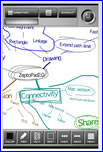 starting by placing topics around the workspace and then drawing circles or rectangles around them and connecting them with lines. You can also draw vector images in Zeptopad, and can adjust the color and thickness of the lines. What’s more, you can take a photo using the iPhone and then import it into your Zeptopaad drawing. Pinch the screen and the workspace expands to provide more space for drawing. You can rotate an object by first selecting it and then moving two fingers in a circular motion. If you’re standing close to another iPhone user, you can use the application’s unique “shake and share” capability to transfer the drawing on the screen to him or her. In addition, you can use Zeptopad and your iPhone with a wireless projector as a mobile presentation device – very cool. You can export your maps and drawings as JPG or PDF files. The cost of Zeptopad is $9.99.
starting by placing topics around the workspace and then drawing circles or rectangles around them and connecting them with lines. You can also draw vector images in Zeptopad, and can adjust the color and thickness of the lines. What’s more, you can take a photo using the iPhone and then import it into your Zeptopaad drawing. Pinch the screen and the workspace expands to provide more space for drawing. You can rotate an object by first selecting it and then moving two fingers in a circular motion. If you’re standing close to another iPhone user, you can use the application’s unique “shake and share” capability to transfer the drawing on the screen to him or her. In addition, you can use Zeptopad and your iPhone with a wireless projector as a mobile presentation device – very cool. You can export your maps and drawings as JPG or PDF files. The cost of Zeptopad is $9.99.
MindMeister
In early January, the developer of MindMeister announced that he plans to release an iPhone version of this popular web-based mind mapping application. It will contain most of the functionality of MindMeister, and should be released around mid-February.
Recommendations
The most attractive usage scenario for these new mapping tools would be to use the iPhone to capture your ideas in a basic mind map, and then transfer it to a desktop mapping application for further development and refinement. While most of these tools enable you to move your maps off of the iPhone, only iThought and iBlueSky enable you to export them in editable form; the rest output your maps as static JPG images or PDF files – not very useful. I give iBlueSky a slight edge because of its tight integration with NovaMind.
I can’t wait to see what developers come up with next on this exciting new mobile platform!



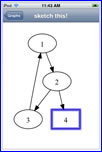
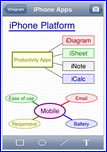
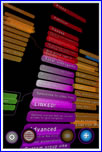
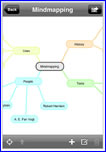
Leave a Reply